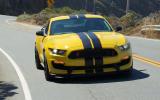What is it?
The new, 526bhp Shelby GT350R Mustang - and Ford isn't shy about what it has been benchmarked against during development. The Porsche 911 GT3 may undercut the big American coupé by a substantial 251kg, but the company with the blue oval badge claims the GT350R is faster than the rear-engined German around a circuit.
Clearly Ford isn’t messing around with its track-focused Mustang. And with the iconic American coupé finally on offer in the UK with right-hand drive, us Brits should be paying closer attention to its efforts than normal.
Part of the GT350R’s impressive pace is no doubt down to lightweight carbonfibre wheels and steamroller-wide Michelin Pilot Sport Cup 2 tyres. The 394mm Brembo brakes and magnetorheological adaptive dampers surely help, too.
But the real story here is the engine. Germany may be the focus for lap times but the influence under the bonnet is Italian. The new 5.2-litre V8 carries a sky-high 8250rpm redline courtesy of Ferrari’s favourite trick: a flat-plane crankshaft. In addition to changing the aural characteristics, a power bump comes along due to superior breathing.
Ford fiddled with the typical flat-plane crankpin set-up and fitted unequal-length 4-3-1 exhaust manifolds versus the usual equal-length 4-1 configuration. These changes help the Shelby sound more like a Ford V8 after too many shots of espresso, instead of a high-pitched southern European.
What's it like?
Thumb the bright-red starter button and the GT350R awakens into a flurry of noise and vibration loud enough to make the Jaguar F-Type R sound restrained. Did you really expect the typical American Mustang buyer to give up the full testosterone-enhancing baritone song?
It’s the quivers from that flat-plane crank, combined with the Honda VTEC-like redline, that are new to the Yankee playbook. Ignore the tachometer and you’re likely to shift the six-speed manual gearbox by 6000rpm, still thinking the Shelby was quite impressive.
But it’s that last quarter of the rev range where the magic really happens. The big naturally aspirated V8 comes alive, developing massive power and sending almost disturbing pulsations through the steering wheel and shifter. We wouldn’t want it any other way.
The Shelby may have the pace of a 911 GT3 on track but the driving experience is the polar opposite. The Porsche rewards its driver with its buttery tactile feedback and perfect chassis composure, where the Shelby begs for abuse and aggressive inputs.
Think of the GT350R as a well-honed sledgehammer. The electric power steering isn’t overly communicative but it’s accurate and gets the job done. Pedal placement also isn’t fabulous, making heel-and-toe downshifts tricky, you feel that quarter-tonne kerb weight penalty versus the 911 GT3 and you’re always aware of the sizeable exterior dimensions.
But drive through those issues and the Shelby comes alive. It’s an absolute animal to drive quickly but it’s not remotely intimidating. Select Track mode on the 20-button-busy steering wheel and the helm weights up, the throttle becomes more alert and the exhaust opens up even further. Fully disable the stability control system and the rewards - or mistakes - are yours to savour. You can lean extremely hard on the GT350R and it never complains.

































Join the debate
Add your comment
Hmmm ...
More on the EPA tests:
The tests employed come out with figures that American magazines pretty much match on their long term test fleets - a little bit of (personal) research goes a long way to clearing the smog (ha-ha) created by the EU lab tests. Once factored for the US/IMP gallon conversion the (EPA) tests also match the figures found on UK long term tests. There are of course problems - for starters far from every car available here are available stateside.
Its funny isnt it how this
winniethewoo wrote: Its funny
I'm not suggesting that the Benter is running 'cheat' software, what I AM saying is that the EPA tests are a damn sight closer to real world, and therefore achievable, figures every time the car is driven. The fault is the tests, not the cars.